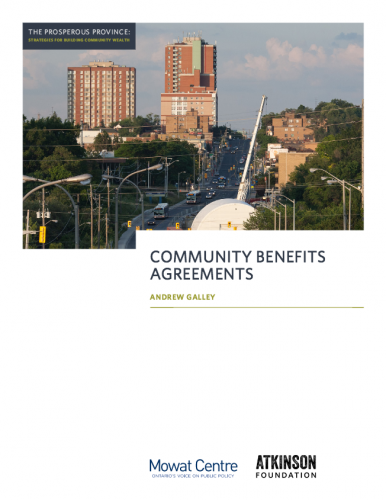Over the next decade, Ontario will invest billions of dollars in infrastructure ranging from transit expansion to new roads and repairs to existing bridges. Cities and towns across the province will also see an influx of public and private capital in land developments designed to meet housing demand and build up underused areas. All of these investments are poised to create substantial new wealth and strengthen the provincial economy.
At the same time, many Ontarians may not share in the prosperity generated by these investments. Income inequality is increasing in the province as it is elsewhere in the Western world. In many larger cities like Toronto, this inequality among individuals is often marked by a growing gap between high and low-income neighbourhoods. Many jurisdictions are exploring a suite of policy approaches known as “community wealth building” in response to these trends.
Community wealth building strategies differ from traditional approaches to poverty reduction by putting a focus on the community in market activities like institutional purchasing or infrastructure construction. They include building community assets, increasing the local capacity for business incubation, and creating decent work as a means to sharing prosperity more broadly and equitably.
Download the Prosperous Province
Community Benefits Agreements (CBAs) are a strategic tool used in the process of building community wealth. CBAs are negotiated agreements between a private or public development agent and a coalition of community-based groups. This coalition may include neighbourhood representatives, single-issue advocates, labour unions, social service agencies, religious congregations, faith-based groups and others. Together, they give a voice to people in infrastructure planning and land development processes – especially those indviduals who have been historically excluded or marginalized from these processes and decisions that affect them.
Coalitions usually draw their membership and build their base for advocacy from neighbourhoods directly surrounding significant projects. Spurred by a concern for the concentration of poverty in their neighbourhoods or cities, they seek to maximize economic opportunities offered by development projects – particularly those subsidized with public funds.
This paper explores CBAs attached to large-scale real estate or infrastructure developments. It situates CBAs firmly in the Ontario context. It looks to the experiences of practitioners in other jurisdictions for lessons and cautions. It also considers how community organizers, public servants and developers can adapt this approach to their current realities.
The paper examines the structure of CBAs and the process for developing them. It will describe the leading examples, the current provincial landscape, and related strategic considerations before drawing some conclusions and identifying next steps.
Table of Contents
FOREWORD
1. Introduction
2. Definition, Process, and Player
3. Community Benefits Agreements in Action
4. Ontario’s Policy Landscape for Community Benefits Agreements
5. Insight from Experience
6. Continuing the Conversation
WORKS CITED
Commissioned by the Atkinson Foundation, this report from the Mowat Centre is intended to support informed discussion and guide decision-making in the emerging field of community wealth-building. The report is part of a research series, The Prosperous Province: Strategies for Community Wealth.
The Mowat Centre undertook the study as part of its commitment to better understand and communicate trends and innovations in economic development, especially those that promote inclusive growth.
The Atkinson Foundation is supporting the study because of its commitment to evidence-based public discourse on issues related to social and economic justice.





